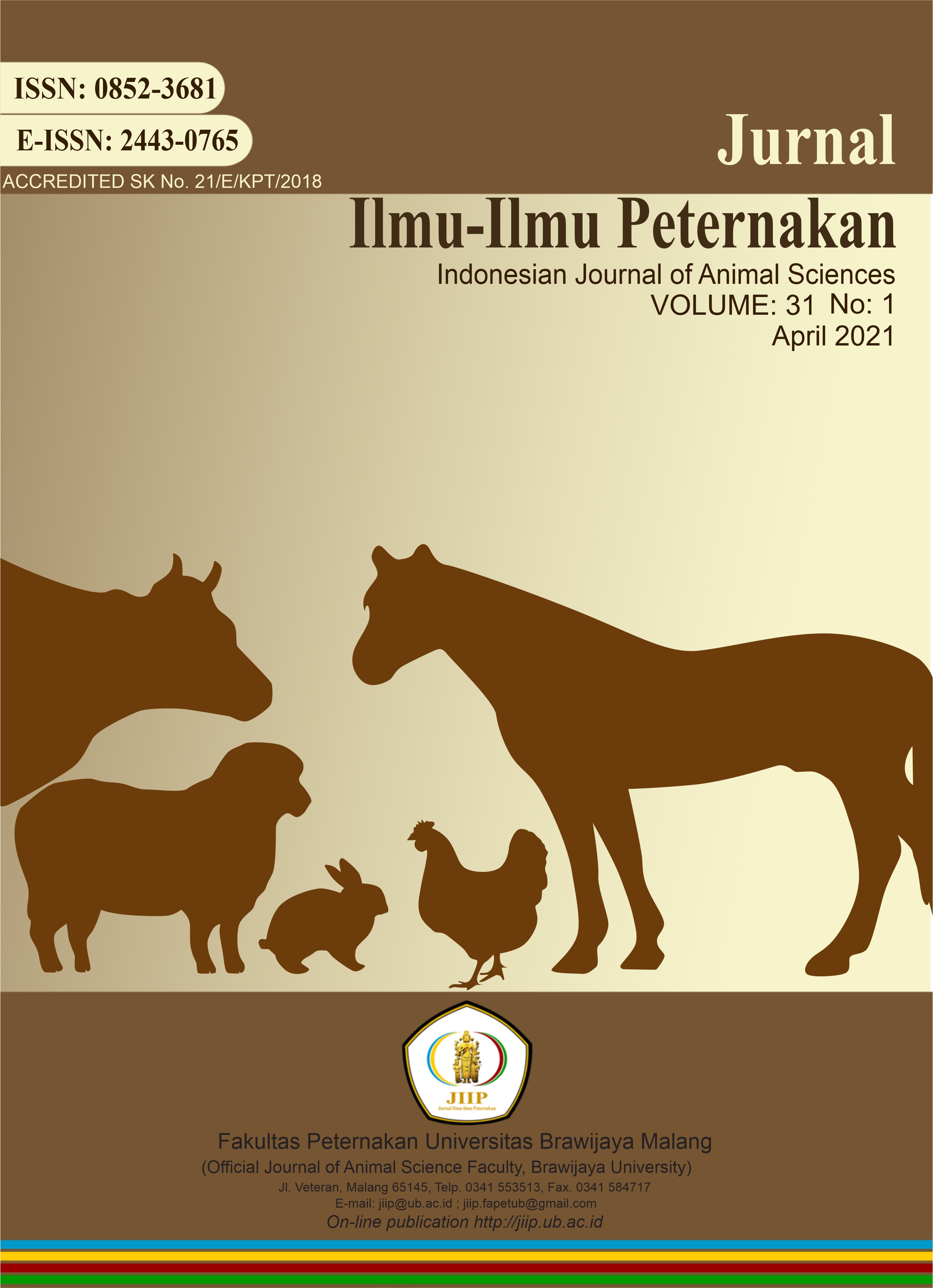Effect of corn substitution with Enzymated apple pomace on broiler production performance and percentage internal organ of broiler chickens
DOI:
https://doi.org/10.21776/ub.jiip.2021.031.01.08Keywords:
Apple pomace, Broilers, Production performance, % of internal organsAbstract
Corn is a feedstuff that use as a major component of energy sources and hard to be replaced other feedstuff in poultry ration, even its use is always above 45% in the composition of poultry feed. However, domestic maize availability is limited and the price is changes depend on season harvest time, and most of the availability for animal feed is still imported. Besides that, there is a ban on the use of Antibiotic Growth Promoter (AGP) in poultry feed and drinking water effectively since January 2018, so an effort is needed to replace AGP with natural feed additives or Natural growth promoters (NGP). Based on the above conditions, it is necessary to make efforts to replace corn with local feed ingredients, one of which is apple extraction pomace (apple pomaces). The pomace of apple extraction, if left unchecked, will quickly rot so that it will potentially as an environmental pollutant. The potential of apple pomace extract can be used as a feed ingredient with high sugar and energy content (2300 kcal/kg BK). This research was conducted in the Field Laboratory of Sumber Sekar, Laboratory of Animal Nutrition and Feed, Faculty of Animal Husbandry, Agricultural Technology Laboratory, Brawijaya University. The experiment used 192 DOC broilers and placed them in 8 postal cages per replication. Research on Enzymanted apple pomaces (EAP) as a substitute for corn used a completely randomized design (CRD) P0: basal feed, P1: substitution of EAP 5%, P2: substitution of EAP 10%, P3: substitution of EAP 15%. The variables observed were the production performances include (feed consumption, weight gain, feed conversion ration) and the % internal organs. Based on the research, the results were not significantly different on the production performances and the % of organs in broilers. The use of apple pomaces can be used as a substitute for broiler feed up to a level of 15%.References
Amrullah, I. (2004). Nutrisi Ayam Broiler. Lembaga Satu Gunung Budi.
AOAC. (2005). Official method of analysis of the association of official analytical of chemist. Virginia.
Bhushan, S., Kalia, K., Sharma, M., Singh, B., & Ahuja, P. S. (2008). Processing of apple pomace for bioactive molecules. Critical Reviews in Biotechnology, 28(4), 285–296. https://doi.org/10.1080/07388550802368895
Bintoro, V. P. (2008). Teknologi pengolahan daging dan analisis produk. Badan Penerbit Universitas Diponegoro.
Dhillon, G. S., Kaur, S., & Brar, S. K. (2013). Perspective of apple processing wastes as low-cost substrates for bioproduction of high value products: A review. Renewable and Sustainable Energy Reviews, 27, 789–805. https://doi.org/10.1016/j.rse r.2013.06.046
Kompiang, I. P., Sinurat, A. P., Purwadaria, S., & Darma, J. (1994). Nutrition value of protein enriched cassava. JITV, 7(2), 22–25.
North, M. O. (1984). Breeder Management. The Avi Publishing Company Inc.
Nuningtyas, Y., Natsir, M., & Sjofjan, O. (2021). Inhibition of pathogenic bacteria in digestive tract of chickens using lime (citrus aurantifolia) and probiotics. International Research Journal of Advanced Engineering and Science, 6(1), 104–110.
Pasaribu, T. (2007). Agro by product fermentation product as poultry feedstuffs. Wartazoa, 17(3). https:// doi.org/10.14334/wartazoa.v17i3.876
Steel, R. G. D., & Torrie, J. H. (1993). Prinsip dan Prosedur Statistika suatu Pendekatan Biometrik. PT. Gramedia.
Yuwanta, T. (2004). Dasar ternak Unggas. Penerbit Kanisius.
Downloads
Published
How to Cite
Issue
Section
License
Authors who publish with this journal agree to the following terms:- Authors retain copyright and grant the journal right of first publication with the work simultaneously licensed under a Creative Commons Attribution License that allows others to share the work with an acknowledgment of the work's authorship and initial publication in this journal.
- Authors are able to enter into separate, additional contractual arrangements for the non-exclusive distribution of the journal's published version of the work (e.g., post it to an institutional repository or publish it in a book), with an acknowledgment of its initial publication in this journal.
- Authors are permitted and encouraged to post their work online (e.g., in institutional repositories or on their website) prior to and during the submission process, as it can lead to productive exchanges, as well as earlier and greater citation of published work (See The Effect of Open Access).
















